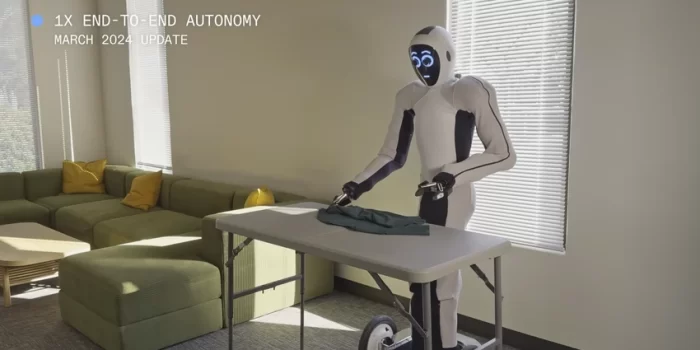The recent advancements in autonomous humanoid robotics, particularly showcased by Norwegian company 1X, in collaboration with American company Figure, indicate a rapid acceleration in the field. Despite lacking the sophisticated legs and hands seen in other companies’ robots, 1X’s Eve robots are making significant strides in learning and capability.
A video released on February 9, 2024, demonstrates the remarkable progress of these robots. They are shown performing multi-step tasks autonomously, such as organizing items from a shopping bag, wiping spills with soft tools, folding shirts without thumbs, and handling physically tricky tasks like folding cardboard boxes. These tasks exhibit a level of sophistication previously unseen in humanoid robots.
The video also slyly references Tesla’s mishap with its Optimus bot, suggesting that while Tesla’s bot initially required human teleoperation, future iterations will likely showcase similar autonomous capabilities as seen in other companies’ robots.
This surge in development marks a pivotal moment akin to the “GPT-3 moment” for humanoid robotics, where they are gaining widespread attention and starting to integrate into various industries. Notable examples include Agility’s Digit at Amazon, Figure’s 01 at BMW, and Apptronik’s Apollo at Mercedes-Benz.
Critics might underestimate the importance of these advancements, yet they mark the initial stages of an industry poised for groundbreaking development. These humanoid robots go beyond mere programming; they are actively learning and adjusting with minimal human input, setting the stage for practical applications across diverse sectors.
Moreover, these strides are happening at an impressive pace, with each new version outperforming its predecessor in terms of both capability and efficiency. The rapid advancement in the field is striking, fueled by continuous enhancements in software and hardware, propelling innovation forward.
These humanoid robots symbolize a paradigm shift in robotics, where machines not only execute physical tasks but also autonomously engage with their surroundings. Despite their current limitations, these robots harbor vast potential to transform industries and everyday activities.
As the field progresses, it becomes evident that we are entering a new era in robotics, where machines possess not only intelligence but also the ability to navigate and interact with the physical world in previously unimaginable ways.


